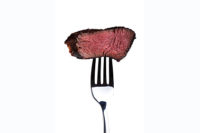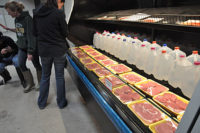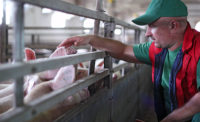Ninety-five percent of human decision-making occurs on a subconscious level. When consumers enter a retail setting, they are heavily influenced by factors that do not enter their conscious realm of thought. Common sensory practices capture consumer perception through hedonic scale measurements used for in-home and central location tests. These sensory tests are designed to understand conscious thoughts from consumers but may fail to capture deeper influences from the subconscious. To capture the subconscious impact on decision-making, eye tracking has been used in several research fields. The objective of this study was to apply eye-tracking methodology in combination with traditional self-reported measures to further understand consumer perception of beef color and marbling.
The official U.S. Department of Agriculture (USDA) Small50 grading card image was edited by an experienced photographer (Adela Fernandez Photography, Adobe Photoshop CC, in San Jose, Calif.) to create different degrees of color (pale, ideal and dark) and marbling (slight, small and modest). By editing this one image to create those three levels of color and marbling, we were able to control the inherent variation that would occur through selecting multiple steaks to obtain these images (i.e. fat thickness, marbling texture, slight color variations, loin eye area). Six trials were created by arranging the images in sets of three where either marbling or color was held constant among the images while the other color or marbling characteristic differed.
Consumers (n = 158) were recruited from the Bryan/College Station area with the stipulation they must be 18 years or older and consume beef. Prior to testing, consent forms were signed informing consumers their eye movements were recorded. Consumers viewed each trial for 10 seconds before automatically advancing to slides where they reported their overall liking of each image on a nine-point hedonic scale in which one = dislike extremely and nine = like extremely. In order to randomize where consumers would begin their observations in the following trial, additional slides were positioned between each trial that contained a randomly placed bullseye.
The design of the study allowed for each steak image to be exposed to each participant twice, but in different comparison scenarios. For example, the image representing a pale, slight steak image was grouped with the ideally colored, slight steak image and the dark colored, slight steak image.
Conversely, the pale, slight steak image was also grouped with the pale, small and pale, modest steak images. This allowed us to measure whether consumer overall liking was similar or different for each steak image with respect to the scenario in which the image was viewed. Analyses showed significant differences in consumer overall liking for seven of the nine steak images. This indicated consumer overall liking of a steak image was contingent upon the details of the surrounding images. Therefore, consumer perception of fresh beef steaks may shift depending on the layout of fresh beef retail products. The position of the steak image (either in the left, middle or right placement) was also important in estimating consumer overall liking. For instance, those placed in the middle of the group were rated significantly higher in liking compared with those placed in the right position.
Eye-tracking metrics used fixation time and the number of consumer revisits to an image to predict consumer overall liking. The intent is that behaviors identified by eye-tracking emulate consumer behavior at the retail meat case. Fixation time measures the attention an individual allocates to a specific region. As fixation time increased, there was greater attention to that area. Revisits were defined as shifts in a consumers’ view away from a specific area for a period of time only to return back to the original area. Revisits may be indicative of a comparison behavior or an attempt to increase one’s understanding of a message.
For every five seconds an image was fixated on, the overall liking of the steak image increased by one unit. In general, as revisits and fixation time increased consumer overall liking increased for images differing in marbling and color. These results indicated that the longer consumers examine beef in the retail meat case, overall liking of the meat’s visual appearance should increase.
Ideally colored steak images were preferred over pale or dark colored steak images. When revisits increased to nine, consumers liked dark and ideally colored steak images similarly. When consumer fixation time was less than three seconds, pale and dark steak images were disliked similarly and more than ideal steak images. As fixation time increased from 3 seconds, consumer overall liking was similar among all three colors. This indicated that when consumers spend more time examining an image they did not differentiate images for color.
Consumers liked steak images with higher degrees of marbling. Therefore, they liked images with modest marbling compared with steak images with small marbling. Additionally, steak images with small marbling were preferred over steak images with slight marbling. As long as consumers had six or fewer revisits to an image, overall liking for marbling steak images differed as previously defined. When consumers had seven or more revisits, steak images with small and slight marbling were liked similarly and steak images with modest marbling were liked most.
When fixation time was three seconds or less, consumers liked steak images with higher degrees of marbling. After eight seconds, however, overall liking was similar for steak images differing in marbling. This may indicate that as consumers view fresh retail beef products for longer periods of time and compare these products, the differences of color and degree of marbling may become less crucial in their purchase decision process. Conversely, consumers who spend less time making purchase decisions, differentiated steak images for differences in marbling and color, but overall liking was lower.
As consumers spent more time fixating and revisiting beef steak images, overall liking of the meat in the images increased, but differences in marbling and color did not resonate to the same extent. Subconscious factors, such as purchasing style, most likely affect consumers’ preference of beef appearance in the retail meat case by influencing the time they take to make a decision. If a purchasing decision is made rapidly, differences in marbling and color affect the decision to a greater extent. For consumers who spend more time making purchasing decisions, however, differences in marbling and color are not as impactful.
This research shows the benefit of incorporating human biometric analyses with traditional sensory practices to reveal more holistic consumer perspective of meat products. Further research on subconscious drivers in meat purchase decisions is needed. NP




Report Abusive Comment